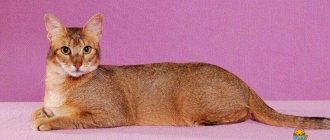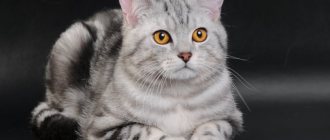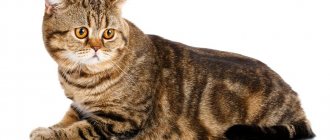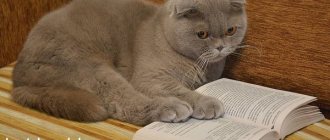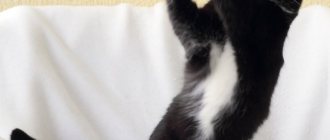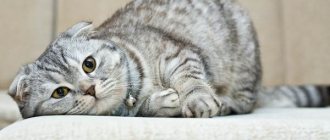The Scottish Straight cat is the “child” of the Scottish Fold. The breed became independent relatively recently. This happened due to the fact that in order for healthy kittens to be born without ear deformation, a cat couple must consist of two different Scots. One of them is straight-eared, the second has flattened ears. But only breeders should delve into these subtleties of breeding. For ordinary people, Scottish straights are large fluffy round clouds that radiate peace and tenderness.
Upon closer contact, it is impossible not to fall in love with one of the plump, purring cats. Thanks to his intelligence, sense of tact and boundless kindness, the Scottish Straight kitten will fit perfectly into any family.
White
The white Scottish Straight is a real miracle, a beautiful, sophisticated animal, the dream of many cat lovers. It’s impossible to look away from the snow-white handsome guy, looking at the world with round, surprised blue eyes. It is believed that owners of a white fur coat are by nature gentle and calm creatures who love to bask in the arms of their beloved owner.
Ginger
A handsome man with a fiery red color almost outshines other colors with the beauty and brightness of his coat. The red kitten looks unusually original and impressive, and the red stripes on the fur, delicate creamy undercoat and golden eyes add even more attractiveness to the cutie. Red kittens have a playful and lively character.
Grey
This color is the most common among straight cats. The gray Scotsman resembles his British relative in the color of his fur coat, but looks more miniature and cute. The solid, rich color of the dense, thick coat makes the baby look like an outlandish animal, and the bright orange eyes enhance this impression.
It is believed that Scots Grays have a calm, phlegmatic character, but they are no less cheerful and active than red ones.
Black
Black straights are unusually elegant and graceful. They can become a true decoration of your home. A shiny, pitch-black fur coat looks incredibly impressive. The aristocratic charcoal color of their coat makes these animals look like a shadow moving unnoticed around the house.
INTERESTING TO KNOW: The St. Petersburg Sphynx is a devoted cat
The deep, attentive gaze of shining amber eyes is always gentle for the owner, but for strangers it can serve as a warning signal - Scottish Straight black smoke does not like strangers. Scots with this type of color behave with dignity and do not allow unnecessary pranks.
Care and maintenance of Scottish cats
Unlike many of their purebred counterparts, Scottish Straights are not demanding or needy to care for. But this does not mean that the lucky person who bought a Scottish kitten is forever freed from any responsibilities. As soon as the little playful creature crosses the threshold of the house, a new stage of life begins for its owner, associated with caring for a teddy cat bear. A straight-eared pet needs attentive and careful treatment and periodic health-improving and preventive measures.
- Grooming. It will take the most time to care for your cat's luxurious coat. Experts advise brushing fluffy cats once a week with a soft brush. Its natural pile should be moderately hard. Scots have a naturally smooth coat that does not tangle. Like other neat cats, Scottish cats keep their fur clean by licking it.
Due to the thick coating, the sensitive intestines may become blocked by a plug of cat hair. This usually leads to serious digestive problems. Therefore, veterinarians advise giving domestic kitties a special paste to remove hairballs.
Scottish cats are bathed as needed, no more than once a month, with the obligatory addition of specialized shampoos.
- Hygiene procedures. Obedient furry cats need their nails trimmed periodically. To do this, use scissors or tweezers. After a “manicure,” the owner should treat each finger with peroxide or a solution of potassium permanganate to prevent infection from entering the body.
The ears need to be cleaned with a cotton swab; this is usually done before bathing the cat. The large and radiant eyes of straights should be wiped with a damp cloth that does not contain “chemicals”.
With careful care, Scottish Straights can live 14-18 years.
Where to buy a straight-eared Scottish kitten
Little bundles can bring a lot of joy to your home. But it’s better to buy them not on Avito, but from certified Scottish straight-eared breeders. Kittens purchased from nurseries are prepared, have no diseases, are litter box trained and have a pedigree. But don’t forget to prepare yourself: purchase a tray, toy and food for the new family member in advance.
The price for a Scottish Straight kitten in Russia starts from 9,000 rubles
. Most of the cost of a kitten is determined by its color.
Breeding nurseries:
- Ermine Trace - Moscow
How to name a Scottish Straight kitten
Getting a kitten is half the battle; he still needs to come up with a name.
After all, the name of a pet is an important component of the life of both the animal and its owner. Straight-eared cats quickly get used to the nickname and respond to it. You can use the suggested nicknames for straight-eared Scots. Table of nicknames for straight-eared Scottish cats
| Girl | Boy | ||
| Abi Asya Buffy Blanca Bianca Waffle Vita Gadget Gretta Dymka Zora Toffee | Laima Mulya Nyuta Paprika Sandra Snezha Tara Toira Tori Fanya Chipa Sherry | Agate Aiko Ice Archie Barry Bars Belyash Vaigar Gizmo Gray Dick Zeus | Iris Cupcake Lex Magnus Murzik Oscar Ray Simba Troyan Fantik Hoshiko Shanti |
Breed health
Scots with straight ears are a breed with good health and reliable immunity. They will delight their households for a long time with their cute faces and kind, gentle disposition. Unlike their lop-eared relatives, they managed to avoid genetic abnormalities and dangerous diseases. However, Scottish Straights are recommended to visit the veterinarian's office several times a year to prevent illness. Owners should check the condition of their ears and teeth from time to time.
Blue
Very often, cats of the Scottish Straight breed have colors of all shades of blue, which give them indescribable grace and sophistication. The color of its fur coat is characterized by a spectacular metallic sheen, giving the animal’s appearance inexpressible grace and charm.
Scottish Straight Blue cats with golden or yellow eyes are inherently calm, but charming kids will never deny themselves the pleasure of being a little naughty.
Lilac
Purple color is quite rare and non-standard. To get such beauty, breeders had to work hard, so such a kitten will not be cheap. The lilac color, unusual for Scottish Straight cats, harmonizes perfectly with the honey eyes of the pet, giving its cute image charm and touching.
Adult lilac cats are extremely elegant and beautiful. Their character is independent and proud, but at the same time loyal and affectionate.
Bi-color
Kittens with multi-colored colors are not so common, and it is impossible to take your eyes off the babies whose fur coats are painted in two shades at once. Color combinations can be any: black and red, black and white, white and gray. According to the official breed standard, bi-colors have yellow eyes, but green ones are also allowed. Seals of this color are not phlegmatic; they spend most of their time in games and fun.
Types of tabby colors
There are four Tabby patterns that have been shown to be genetically distinct: Mackerel, Classic, Spotted and Ticked.
The fifth pattern includes Tabby as part of another primary color pattern. A patched tabby is a calico or tortoiseshell cat with multi-colored patches (also known as caliby and torbie, respectively).
All of these patterns were found in randomly bred populations. Several additional patterns of this color are found in certain breeds, for example, a modified classic Tabby is seen in the Sokoke. Some of them are associated with the interaction of wild and domestic genes. Rosette and marble patterns are characteristic of the Bengal breed.
Sokoke
Silver Bengal
Thus, even a shallow study of genetic inheritance makes it possible to assume that there are many types of Tabby colors, but the most common of them are the following:
- brindle;
- marble;
- spotted;
- ticked;
- tortoiseshell.
Spotted Tabby
Spotted minke whales have linear markers in their color, divided into spots, which can be located vertically or horizontally. A 2010 study suggests that spotting is caused by modification of mackerel stripes and can cause different phenotypes, such as "broken-type" stripes, through multiple loci.
Ticked Tabby or the T allele usually results in a non-patterned agouti tabby with virtually no stripes or lines.
The stripes often remain to some extent on the face, tail, limbs, and sometimes on the chest in heterozygotes and almost none in homozygotes. Ultimately, the dominant tabby allele is dominant and therefore completely (or mostly) masks all other tabby alleles, hiding other patterns.
Spotted Striped Tabby is a modifier that breaks up the Tabby Mackerel pattern so that the stripes appear as spots. Likewise, the stripes of a classic striped pattern can be broken up into larger spots.
This color can be seen in the Australian Mist, Bengal, Serengeti, Savannah, Egyptian Mau, Arabian Mau, Maine Coon and Ocicat.
Australian mist
brindle tabby
The Ticked (or Stripeless) pattern creates agouti hair, strands of hair with distinct stripes of color, breaking up tabby patterns into “salt and pepper” or “sand.” Residual stripes or "medallions" can often be seen on the lower legs, face and belly, and sometimes at the tip of the tail, as well as a long dark line running along the back, usually along the spine.
A striking representative of this color is the Toyger, a breed that appeared on the basis of the Bengal.
Little Toyger
Mackerel tabby
The Mackerel pattern (often called "Striped Mackerel" in foreign sources) has vertical, slightly curved stripes on the sides of the body. They are narrow and can be continuous or broken into sections and spots on the body and belly.
The "M" mark appears on the forehead along with dark lines on the cat's cheeks and at the corners of her eyes. "Mackerels" are also called "fish seals" and are the most common tabby pattern.
Classic tabby
Classic (also known as "Spotted" or "Marble") Tabby typically has patterns of dark brown, ocher and black, but also comes in all colors except white. These animals are sure to have an "M" mark on the forehead, and the body marking is a swirling or spiral pattern (often called a "bull's-eye") on the sides of the cat.
There is also a light butterfly marker on the shoulders and three thin stripes (the central one is dark) running along the spine. Like Tabby Mackerel, Classic Mackerel have dark lines on the legs, tail and cheekbones.
Chinchilla
A kitten or adult Scottish Straight cat with such a spectacular color looks amazing. Breeders do not skimp on laudatory epithets for cats with similar coat colors, comparing them to silver or black pearls. Indeed, wool of such a rare and complex color looks like an exquisite jewel.
Visually, the coat looks like a single color, but if you look closely, you can see a thin “spraying” on the coat. This effect is achieved by painting the ends of the hairs to 1/8 of the length. There are at least ten variations of chinchilla color: lilac, chocolate, as well as cream and red (cameo). The eyes should be green. By nature, chinchillas are calm and friendly.
INTERESTING TO KNOW: The beauty of the Egyptian Mau cat
History of the Scottish Straight cat breed
Scottish Straight cat
Scottish Straight are the same Scottish folds, but with a modified position of the ear. Straight ears do not have a characteristic crease and are set straight, and this, in fact, is the only external sign that distinguishes them from their fold-eared counterparts. Scottish cats are considered one of the youngest cat breeds. The first cat with an unusual, flattened ear shape appeared on a Scottish farm in the early 60s. Surprisingly, the ancestor of modern folds and straights had no pedigree and simply chased mice through the barns of local peasants.
The first official Scottish breeder was an ordinary villager, William Ross, who adopted a kitten from the aforementioned Fold. A few years later, professional breeders also joined the process. At the same time, experts witnessed an interesting phenomenon: in the litters brought by even the most purebred Scottish dogs, babies with erect ears appeared. Of course, no one intended to separate such individuals into a separate breed. And kilometer-long queues did not line up for straight-eared kittens, because against the backdrop of touching folds, they were outright losing. But here nature itself intervened.
Very soon, Scottish breeders noticed that attempts to strengthen and strengthen the lop ears of animals had a negative impact on their health. The mutated gene responsible for the flatness of the ear folds began to inhibit the function of the skeletal apparatus of cats. As a result, the Scots began to suffer from thickening of the bones and osteochondrodysplasia. To keep the breed afloat, breeders rushed to look for “new blood” that would help the Scottish survive and reduce the number of their genetic defects. Through trial, error and outcrossing, it was discovered that the healthiest and most beautiful offspring can be obtained from crossing a Fold cat and a straight-eared male of the same breed. It was thanks to this discovery that breeders and felinological associations finally turned their attention to straight-eared Scots. Well, in 2004, the Scottish Straight subspecies received official recognition from the World Cat Federation and the status of an independent breed, which sharply increased the attractiveness of straight-eared cats in the eyes of potential buyers.
Marbled silver (tabby, tabby)
Scottish straight marble on silver is a worthy specimen that no breeder would refuse. The animal's coat is simply magnificent: a thick white undercoat, on which there are black patterns and stripes. Kittens of such a magnificent color, like those from the Whiskas advertisement, are characterized by huge, expressive yellow eyes. It is believed that marble pussies are very capricious and more touchy than their chocolate relatives.
Tabby Color Genetics
Tabby patterns are caused by three different gene loci and one modifier.
The Agouti gene, with its two alleles A and a, controls whether or not the Tabby pattern is present. The dominant A expresses the basic Tabby pattern, and the recessive "non-Agouti" or "hypermelanistic" allele indicates its absence. Solid (black or blue) cats have an "a" combination that hides the striped pattern, although traces of it can sometimes be seen (called a "ghost stripe"). This basic pattern, whether classic, tabby, spotted or ticked, is most easily distinguishable in bright light during the early stages of a kitten's development and into adulthood on the tail.
However, the Agouti gene only controls the production of black pigment, so a cat with the O allele (responsible for orange or red color) will still express a tabby pattern. As a result, both red cats and red spots on cat skins will always display striped patterns.
The tabby cat's primary pattern gene is dominant, so it is a cat with the Mc genotype (mc or Mc) - mackerel.
The "Mc" set establishes the basic pinstripe pattern (striped mackerel) that underlies the coat. Mc is the wild type Tabby gene. Classic tabby cats are animals that have two copies of the recessive mc, so they are carriers of the mc/mc allele. This is a recessive mutant (not wild type) mc gene that produces the spotted pattern and appears in the cat as the classic pattern of thick stripes with a bullseye pattern on the sides.
The spotted gene is directly related to the Mc gene, it “breaks” the Tabby stripe lines, turning them into spots. It is also dominant, designated Spotted or Sp (sp or Sp). Sp together with Mc and Agouti make up various combinations - mc and Mc/Mc and A/ a and A/A.
The Ticked tabby pattern is at a different gene locus than the Mackerel and Classic tabby patterns, and is epistatic to (influenced by) other patterns. The dominant Ta/ta mutation masks any other Tabby pattern, creating a striped background or agouti stripe with virtually no lines. If the Ticked tabby pattern gene is present, any other Tabby pattern is masked.
Cats homozygous for the marked allele (Ta/ta) have fewer medallion defects than cats heterozygous for the marked allele. When a cat of this genetic makeup is selectively bred for lack of faults and broad stripes on the hair shaft, the resulting pattern is called shaded.
There are additional alleles and even additional genes influencing Tabby patterns that have also been identified and postulated.
The three most common alleles in order of dominance are Ta, the allele for ticked patterns as in the Abyssinian type, Tm, for tabby mackerel, and the recessive tb for classic.
The Ta allele is dominant over Tm and tb.
A cat with the Ta allele will express a ticked tabby pattern (only with stripes on the paws if there is only one copy and none at all if there are two), and a cat with two tb alleles will express the classic stripe pattern.
The wild type is the mackerel (the stripes look like thin fish bones and can break up into linear markers or spots), the most common variety is the classic striped pattern (wide stripes, curls and spirals of dark color on a pale background, usually with bullseye on the side) and, Perhaps the most famous of the less common tabby cat designs is the “swoosh.”
Classic tabbies are most often found in Iran, England and the lands that were once part of the British and Persian empires. The gene responsible for differentiation pattern formation was named transmembrane Q (Taqpep), which also underlies the coat color of the king cheetah.
King Cheetah
Other pattern modifier genes are responsible for creating different types of spotting, many of which are variations of the basic mackerel or classic pattern. There are also hypothetical factors that influence the timing and frequency of Agouti shifts, affecting the width of its band and the quantity and quality of alternating eumelanin and pheomelanin lines on individual hairs.
There is also a gene, not yet identified but believed to be related to the Agouti gene, in the Chausie breed that produces silvery black fur similar to the Abyssinian. It is assumed that the "gray" phenomenon is inherited from the hybridization of the domestic cat with the House (Felis chaus).
Black Chausie
The pigment gene, I/i, is also inhibited. The dominant allele (I) produces hairs with tips of a different color, which are completely colored only on it and have a white base. This allele appears to interact with other genes to cause varying degrees of coloration, ranging from dark-tipped silver tabby to lightly shaded silver and silver chinchilla. The inhibitor gene interacts with the non-Agouti genotype (I-aa) to produce a color known as smoke.
The homozygous recessive genotype combined with the agouti gene (iiA) produces the Tabby's coloration, which can range across the spectrum from a deep-patterned brown tabby to a light yellowish, slightly tinted golden or chinchilla gold. Orange cats with the inhibitor (IO) gene are commonly called "cameos".
Still, the Tabby pattern exists thanks to the Agouti gene. Their stripes have an even distribution of pigment, while the background consists of banded hairs. Tabby cats usually have the following characteristics:
- Mark in the form of the letter "M" on the forehead. Visible in marked tabby cats, but difficult to distinguish in darkened silver and golden animals.
- Thin “pencil” lines on the muzzle. Clearly visible in tabby cats, but more difficult to notice in darkened silver/golden pets.
- Black "eyeliner" and white or pale fur around it.
- Pigmented lips and paw pads.
- Pink nose with darker pigment.
- Ring “girth” of the body, legs and tail. The stripes on the torso disappear when the color is ticked.
Marble on gold
Exquisite and rich color, quite rare among straight cats. Golden wool has clear dark stripes in the form of various black shapes, zigzags, and stripes. Animals with silver and gold marbled colors have the letter “M” on their foreheads, and their eyes are predominantly yellow and copper.
A kitten that has such a luxurious color has a freedom-loving character and does not tolerate coercion. As a rule, owners try to give their pets sophisticated nicknames.
Calico (patchwork turtle)
Only Scottish Straight cats can have this color. The main white color of the fur coat is effectively combined with two more colors: red, black, cream. They say that a three-colored “child”, which must have a corresponding nickname, brings happiness.
It’s hard to say whether this is true or not, but it’s a fact that no one can remain indifferent to such a lovely little girl. Tortoiseshell cats are in high demand among breeders, because later they can produce kittens of a wide variety of colors.
History of Tabby color
Tabby is sometimes mistakenly called a cat breed, but it is only a color variety.
In fact, the tabby pattern occurs in many breeds and is a genetic trait common in the general mixed breed population.
The striped pattern is a natural feature that may be related to the coloration of the direct ancestor of domestic pets, the African wildcat (Felis lybica lybica), which, along with the European wildcat (Felis silvestris silvestris) and the Asian wildcat (Felis lybica ornata), have similar colors .
An in-depth scientific study has shown that five genetic clusters are collected from tabby ancestors of wild cats in different parts of the world.
Since the Tabby pattern is a common wild type, it can be assumed that medieval cats were of this color.
However, some scientists believe that this is not true, at least in England. A little later than the mid-17th century, the naturalist John Aubrey noted that William Laud, Archbishop of Canterbury, was “a great cat lover” and his menagerie “was represented by some Cypriot animals, that is, our tabby pets.” He argued that the common variety of English cats had a white color with some bluish inclusions, which was later practically lost. However, most illustrations or drawings of cats in medieval manuscripts do show them to be tabby.
The English term "tabby" comes from the translation of the French phrase "striped silk taffeta", the root of which is tabis, meaning "rich wet silk".
The word originated in France around the 14th century and is derived from the Arabic term "attabiya", which is a reference to the area in Baghdad, Attabiya (named after Prince Attab of the Umayyad Caliphate) where such silk fabric was first made.
"Tabby" can also be compared to the Spanish word "ataviar", which means "to decorate, put on or wear" and often implies luxurious clothing.
Use of the term "Tabby cat" began in the 1690s and was later shortened to Tabby in 1774.
The concept that "Tabby cat" refers to a female may be a reference to the female proper name Tabitha.
Color point
A kitten with this color is very beautiful. The plush coat is painted in one color, and on the protruding areas of the body - the muzzle, ears and tips of the paws - there are dark points with clear boundaries, which give the blue-eyed Straight a resemblance to a Siamese. Reviews from the owners of these charming animals indicate that color points are distinguished by their neatness and cleanliness.
Shaded colors
The undercoat is almost white, the ends of the hairs are whitish. Almost the entire edge is covered with one color or another, only the chin and abdomen are completely light.
Shaded can be:
- Golden. The undercoat is light peach, the fur has a golden glow. The eyes are green, the paw pads and nose are dark chocolate.
- Silver. The undercoat is snow-white, the tips of the hairs are dark gray. The eyes are greenish, edged with black. The last feature is characteristic only of the silver variety; other Scottish shaded colors do not have eyeliner. The nose mirror is brick-colored. Black edging of mouth and nose, pads.
- Red, aka Cameo. This variety of shaded color has a snow-white undercoat, and there is a dark red coating on the coat. Only the muzzle and chin, the abdomen and the underside of the tail remain completely light. The eyes are like amber. The nose, eyeliner and pads are pinkish.



